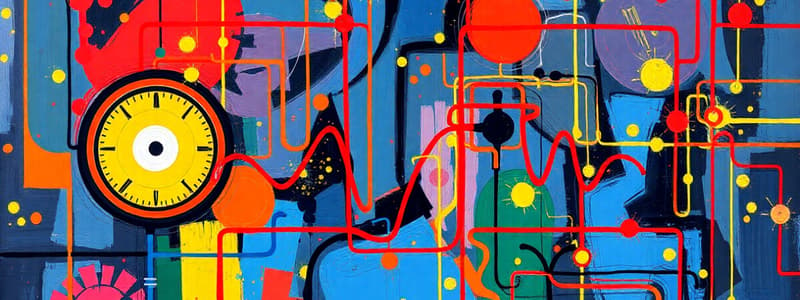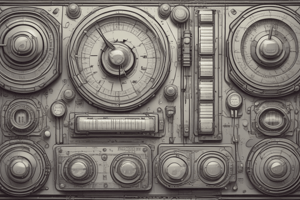Podcast
Questions and Answers
What type of current is characterized by the flow of charge in one direction only?
What type of current is characterized by the flow of charge in one direction only?
- Impedance current
- Direct current (d.c.) (correct)
- Alternating current (a.c.)
- Pulsating current
Which of the following statements is true regarding alternating current (a.c.)?
Which of the following statements is true regarding alternating current (a.c.)?
- The current is constant and unidirectional.
- The charge flows in only one direction.
- The charge changes direction periodically. (correct)
- The charge does not change direction.
In the UK, what is the frequency of the domestic alternating current supply?
In the UK, what is the frequency of the domestic alternating current supply?
- 60 Hz
- 70 Hz
- 40 Hz
- 50 Hz (correct)
What voltage typically characterizes the domestic a.c. supply in the UK?
What voltage typically characterizes the domestic a.c. supply in the UK?
How do batteries and cells supply electrical energy?
How do batteries and cells supply electrical energy?
What is the primary function of the live wire in electrical systems?
What is the primary function of the live wire in electrical systems?
Which type of current is commonly used in household outlets?
Which type of current is commonly used in household outlets?
What happens to the direction of charge movement in alternating current (a.c.) over time?
What happens to the direction of charge movement in alternating current (a.c.) over time?
Which wire is responsible for completing the electrical circuit by returning current to the source?
Which wire is responsible for completing the electrical circuit by returning current to the source?
What is the main difference between live and neutral mains wires?
What is the main difference between live and neutral mains wires?
Which of the following is a characteristic of direct current (d.c.)?
Which of the following is a characteristic of direct current (d.c.)?
What term describes the periodic reversal of charge direction in alternating current?
What term describes the periodic reversal of charge direction in alternating current?
What is the relationship between power ratings of domestic appliances and stored energy when they are in use?
What is the relationship between power ratings of domestic appliances and stored energy when they are in use?
What is the primary function of a resistor in an electric circuit?
What is the primary function of a resistor in an electric circuit?
Which equation relates potential difference, current, and resistance?
Which equation relates potential difference, current, and resistance?
How does increasing resistance in a circuit affect the current flow?
How does increasing resistance in a circuit affect the current flow?
What happens to the energy transferred in a resistor when an electric current flows through it?
What happens to the energy transferred in a resistor when an electric current flows through it?
What unit is used to measure electric current?
What unit is used to measure electric current?
Which factor does NOT affect the resistance in a conductor?
Which factor does NOT affect the resistance in a conductor?
In a series circuit, what happens to the total resistance when more resistors are added?
In a series circuit, what happens to the total resistance when more resistors are added?
What is the formula for calculating power in an electric circuit?
What is the formula for calculating power in an electric circuit?
What does a variable resistor allow a user to do within a circuit?
What does a variable resistor allow a user to do within a circuit?
What role does an electric potential difference play in a circuit?
What role does an electric potential difference play in a circuit?
Which component is primarily responsible for reducing current in a circuit?
Which component is primarily responsible for reducing current in a circuit?
If the current in a circuit is doubled, what happens to the power output assuming resistance remains constant?
If the current in a circuit is doubled, what happens to the power output assuming resistance remains constant?
In an electric circuit, what is an effect of high resistance?
In an electric circuit, what is an effect of high resistance?
What is the effect of reducing potential difference across a circuit?
What is the effect of reducing potential difference across a circuit?
Flashcards
Direct Current (DC)
Direct Current (DC)
Flow of electric charge in one direction.
Alternating Current (AC)
Alternating Current (AC)
Flow of electric charge that reverses direction periodically.
Mains Voltage
Mains Voltage
Voltage of the electrical supply in the UK (approximately 230V).
Mains Frequency
Mains Frequency
Signup and view all the flashcards
Domestic Electrical Appliances
Domestic Electrical Appliances
Signup and view all the flashcards
Power Rating
Power Rating
Signup and view all the flashcards
Stored Energy
Stored Energy
Signup and view all the flashcards
Live Wire
Live Wire
Signup and view all the flashcards
Neutral Wire
Neutral Wire
Signup and view all the flashcards
Electrical Safety
Electrical Safety
Signup and view all the flashcards
Power
Power
Signup and view all the flashcards
Voltage
Voltage
Signup and view all the flashcards
Electrical Circuit
Electrical Circuit
Signup and view all the flashcards
Electric Charge
Electric Charge
Signup and view all the flashcards
Electric Current
Electric Current
Signup and view all the flashcards
Electric Circuit
Electric Circuit
Signup and view all the flashcards
Current (I)
Current (I)
Signup and view all the flashcards
Potential Difference (V)
Potential Difference (V)
Signup and view all the flashcards
Electrical Resistance (R)
Electrical Resistance (R)
Signup and view all the flashcards
Ohm's Law
Ohm's Law
Signup and view all the flashcards
Energy Transfer (E)
Energy Transfer (E)
Signup and view all the flashcards
Power (P)
Power (P)
Signup and view all the flashcards
Power Equation
Power Equation
Signup and view all the flashcards
Power Equation 2
Power Equation 2
Signup and view all the flashcards
Variable Resistor
Variable Resistor
Signup and view all the flashcards
Series Circuit
Series Circuit
Signup and view all the flashcards
Parallel Circuit
Parallel Circuit
Signup and view all the flashcards
Filament Lamp
Filament Lamp
Signup and view all the flashcards
Diode
Diode
Signup and view all the flashcards
Fixed Resistor
Fixed Resistor
Signup and view all the flashcards
Energy Transfer in Devices
Energy Transfer in Devices
Signup and view all the flashcards
Study Notes
CP9 Electricity and Circuits
- CP9a Electric Circuits:
- Atoms are made up of protons, neutrons, and electrons.
- Electrical symbols are used to represent electrical components in circuits (e.g., cells, switches, voltmeters, ammeters, lamps).
- Circuit diagrams use conventions for positive and negative terminals.
- Identical lamps in series have different brightness levels than identical lamps in parallel.
- The number of lamps, cells, or switches affects the brightness and current in series or parallel circuits.
CP9b Current and Potential Difference
- Measuring Voltage: How to measure voltage.
- Potential Difference: Definition of potential difference.
- Measuring Current: How to measure current.
- Electric Current: Conditions needed to produce an electric current (a complete circuit and a voltage source).
- Current at a Junction: Behavior of current at a junction.
CP9c Current, Charge, and Energy
- Potential Difference, Charge, and Energy Transfer: Link between potential difference (voltage), charge, and energy transferred across a battery or component.
- Volt: Unit of potential difference (energy transferred per coulomb).
- Energy Transfer Equation: Equation relating energy transferred, charge, and potential difference (E = Q × V).
- Electric Current and Electric Charge: Link between electric current and electric charge.
- Current in Metals: Explanation of electric current in metals based on electrons.
- Charge, Current, and Time Equation: Equation relating charge, current, and time (Q = I × t).
CP9d Resistance
- Resistance and Variable Resistors: Effects of changing resistance in a circuit, variable resistors.
- Potential Difference, Current, and Resistance Equation: Potential difference (V) = current (I) x resistance (R), (V=I x R).
- Resistances in Series and Parallel: Why net resistance increases in series and decreases in parallel.
- Series Circuits Calculation: Calculating currents, potential differences, and resistances in series circuits.
- Series Circuits Design: Design and construction of series circuits for testing.
CP9e More About Resistance
- Resistance Variation: How current varies with potential difference for filament lamps, diodes, fixed resistors, LDRs, and thermistors.
- Light-Dependent Resistor (LDR): How resistance changes with light intensity.
- Thermistors: How resistance changes with temperature (negative temperature coefficient).
- Filament Lamps, Diodes, LDRs, Thermistors Explaining how to investigate the relationships between potential difference, current, and resistance for different circuit components.
CP9f Transferring Energy
- Energy Transfer in Resistors: Energy transfer in resistors when there's an electric current.
- Thermal Energy Dissipation: Explanation that electrical energy is dissipated as thermal energy in the surroundings.
- Electron-Ion Collisions: Energy transfer in circuits due to collisions between electrons and ions in the lattice.
- Low Resistance Wires: Ways to reduce unwanted energy transfer through low resistance wires.
- Heating Effect Advantages and Disadvantages: Advantages and disadvantages of the heating effect of an electric current.
- Equation for Energy Transfer: Energy transferred (joules) = current (amps) x potential difference (volts) x time (seconds)
CP9g Power
- Power Explanations: Power described as energy transferred per second, with watts as the unit.
- Power Equation using Energy and Time: Power (watts) = energy transferred (joules) / time taken (seconds).
- Power Equations for Circuits: Electrical power equations relating power, current, voltage (P = I x V) and current, resistance (P = I² x R).
CP9h Transferring Energy by Electricity
- Energy Transfer in Devices: Mechanisms for energy transfer in various domestic devices (motors, heating devices).
- Direct and Alternating Voltage: Differences between direct current (DC) and alternating current (AC).
- Domestic AC Supply: Explanation of the UK's domestic supply (AC, frequency, and voltage).
- Electrical Appliances and Storage: The relationship between power ratings of domestic appliances and changes in stored energy.
CP9i Electrical Safety
- Live, Neutral, and Earth Wires: Explanation of the differences in function between live, neutral, and earth wires.
- Earth Wire Function: Function of an earth wire.
- Fuses and Circuit Breakers: Fuses and circuit breakers in ensuring safety within a circuit.
- Switch and Fuse Connections: Explanation of why switches and fuses should be connected to the live wire in residential circuits.
- Potential Differences (Live, Neutral, Earth): Explanation of the potential differences between the live, neutral, and earth mains wires (live=230V, neutral=0V, earth=0V)
- Live-Earth Connection Dangers: Dangers of providing a connection between the live wire and the earth.
Studying That Suits You
Use AI to generate personalized quizzes and flashcards to suit your learning preferences.





